Have you ever thought about raising your own backyard chickens? It is actually easier than having a garden. Today, I’m going to take you through everything you need to know about how to take care of chickens.
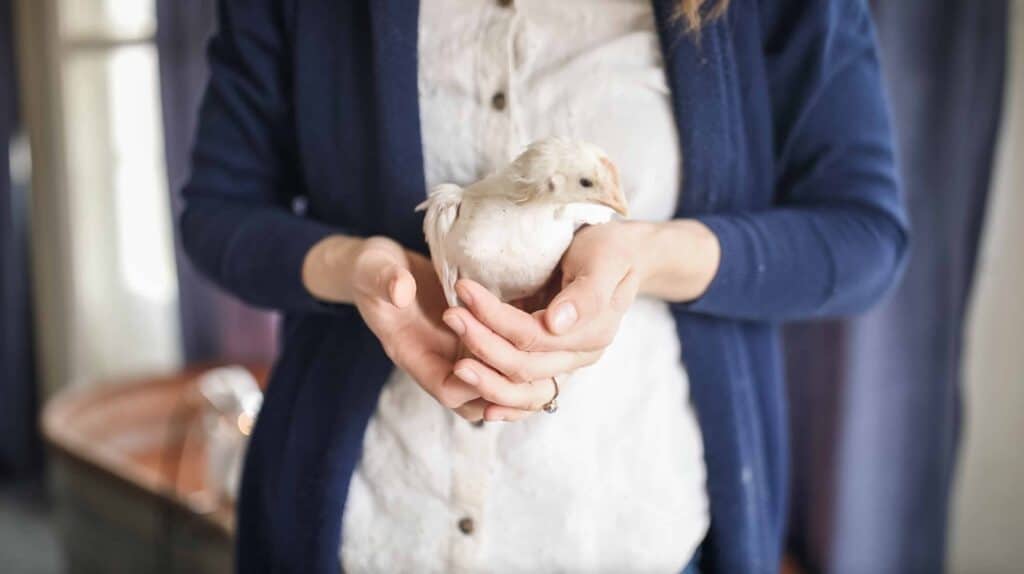
Recently, we went to a local farm store to buy a batch of chicks. We had five chickens at our old house, but when we moved, we asked our neighbors if they would like to add our chickens to their flock.
We didn’t really want to move the coop and move the chickens to another place. Our neighbors at our old farmhouse have always had chickens as well, so they took them and we decided to start fresh.
At our last farmhouse, we lived in town on a quarter of an acre. Now, on our 7-acre farm, we can fit quite a few more chickens. This time around, we bought 12 chicks to expand our flock.
When you go to pick up chicks from the store, you can purchase a “straight run” or “pullets”. Straight run chickens mean that they can be male or female chickens, so you have a 50/50 shot per bird at getting hens.
If you got 12 straight run chickens, you might end up with six roosters, six hens or any combination of roosters and hens. You really can’t know at the time.
Pullets, on the other hand, are known to be female chicks. We decided to go with pullets, because we have bought the straight run before, raised them, and then found out that most of them were roosters.
Since we were right in the middle of town, we didn’t want to hear the rooster crow. We just wanted hens and eggs.
If you are raising chicks for meat birds and eggs, a straight run may be a better option!
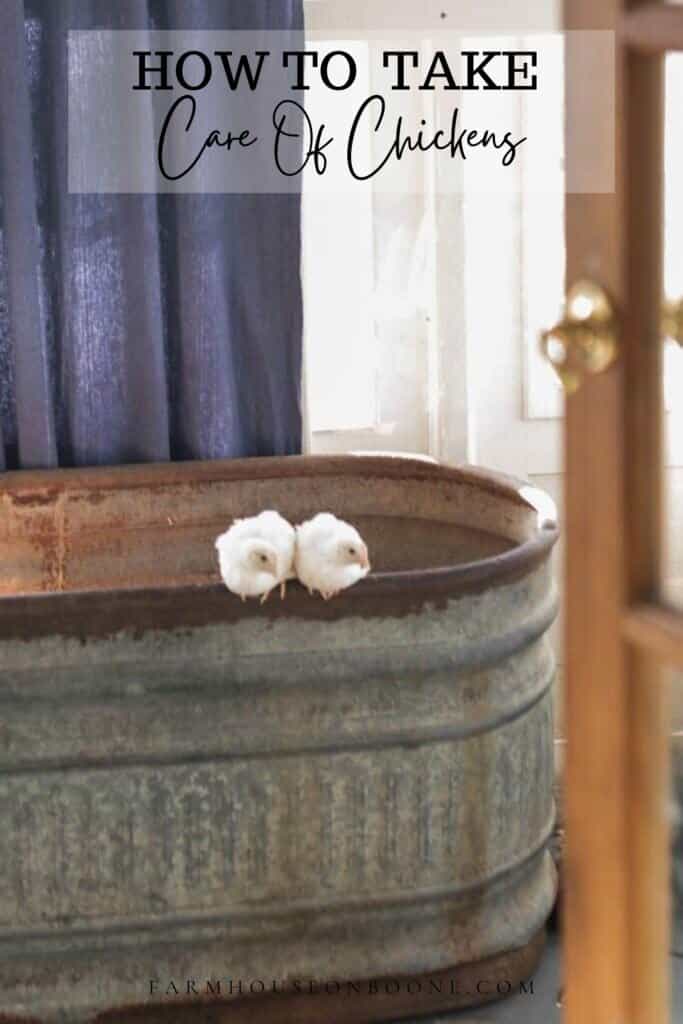
How to Take Care Of Chickens Video
How To Take Care Of Chickens: Essentials
#1 A Brooder
The first thing you are going to need is a brooder. A brooder can be anything from a cardboard box to a plastic tote. I have seen people use homemade wooden boxes, or even designated brooders that you can purchase at your local farm store.
We are using a good-sized galvanized stock tank that my parents gave us. This tank had a hole in it, so it doesn’t work for watering, but it works great for our chick brooder!
#2 Bedding
The next thing you are going to need is bedding. We picked up some pine shavings and spread a layer on the bottom of the brooder.
You are going to have to clean out the bedding somewhat regularly, because it gets stinky and dirty pretty quickly.
Around six weeks, you can put the chicks outside depending on the weather in your area. You don’t want it to get too cold at night for them. As long as you have outside shelter, which we will talk about later, you can move them outside.
A barn, basement, garage, or mudroom are all great options for housing your chicks. They don’t take up too much room at first, but chicks grow pretty rapidly. After a month, ours still comfortably fit inside our big galvanized tank.
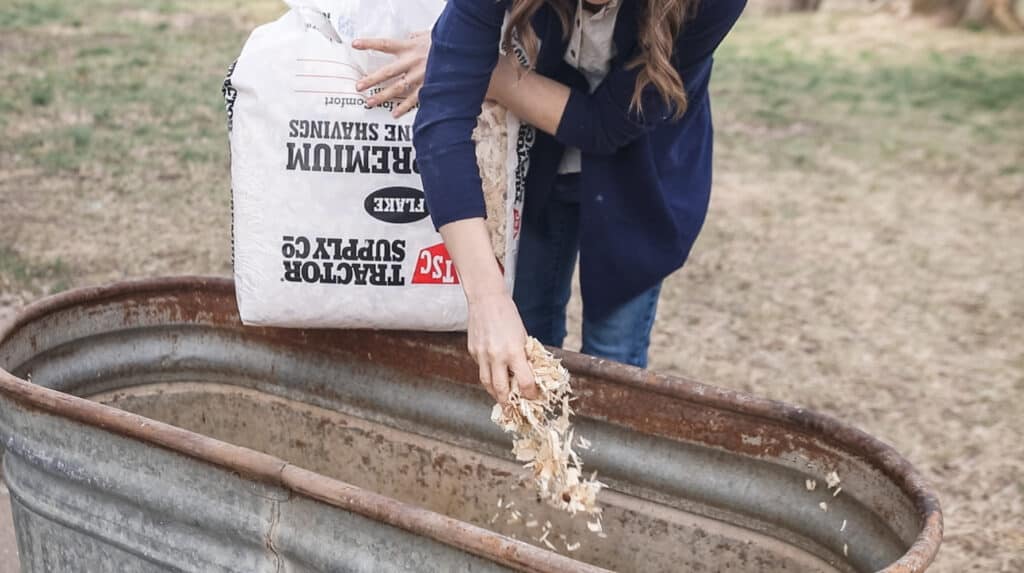
#3 Heater
The third thing you need is a heat source. When you first bring your baby chicks home, they need about a 95 degrees Fahrenheit temperature.
There are several options, but we always just use a heat lamp. I love the one we have because it has a little cage underneath the light, so that if it accidentally falls off, it won’t burn anything.
You want to pay attention to the chicks and make sure they are not going to the outer extremities of the brooder to get away from the heat. If they are doing that, you are going to want to move the lamp up a bit so they will not get too hot.
I noticed that our chicks go around the full length of the brooder, but at night they all gather underneath the lamp. That tells me it is still at the right temperature for them.
#4 Feed and Water
You will need some kind of system to offer your chicks fresh feed and water.
We use this Little Giant Plastic One Quart FeederBase. I love it because it just screws onto a normal Mason jar. It is easy to keep clean and easy to fill.
We use the same for the water. The Little Giant One Quart Screw-on Poultry Waterer Base is a continuous drip waterer. You might want to set your feeders up on a piece of cardboard, or a little piece of wood, so that the chicks don’t instantly get all the bedding dirty.
Our chicks are just getting large enough now that they fly right out of the brooder. Since we aren’t finished building the coop or to move them outside yet, we put a piece of wire over the top.
#5 The Chicken Coop
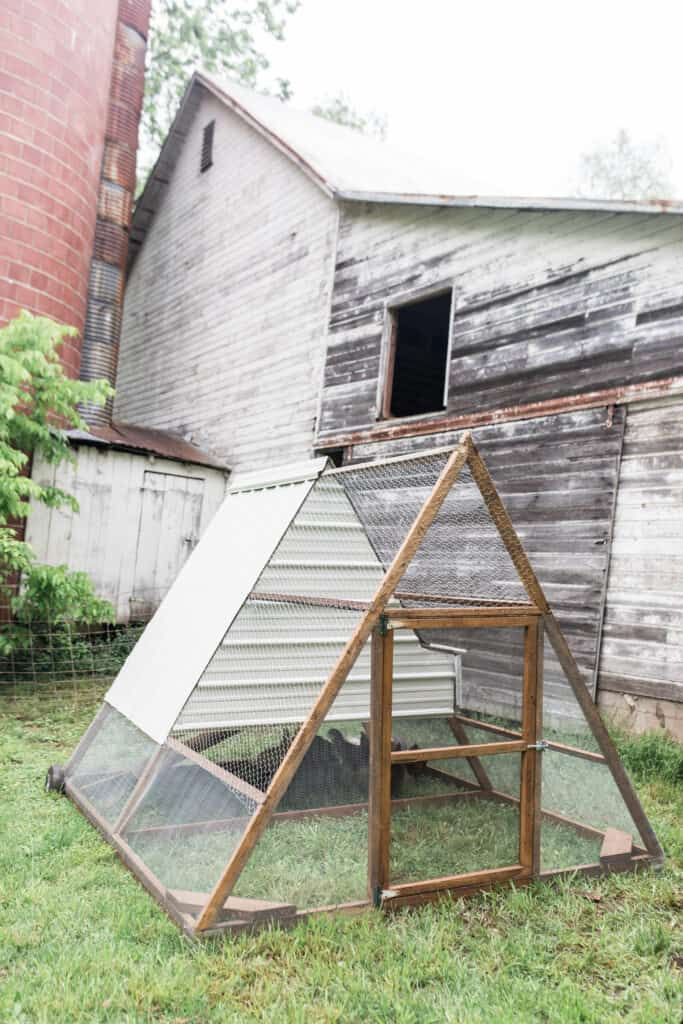
When your chicks are six weeks old and fully feathered, they are ready to be moved outside, but they will need shelter that is secure from predators. In a lot of areas, the biggest threats are dogs, birds that swoop down and eat chickens, animals that burrow under the shelter, and coyotes.
There are many varieties of coops you can buy from your local feed store, Craigslist, or Facebook Marketplace if you do not want to invest a lot of time in building one. This moveable chicken coop houses up to 5 chickens and would be perfect for a backyard.
At our old farmhouse, we would lock our chickens up at night so that predators could not get them, but we let them out during the day.
For our new farmhouse, Luke is building an A-frame chicken tractor coop. Every morning and evening, we will move the coop to a new plot of grass, so that the chickens have fresh bugs and foliage to peck.
Not only is this super healthy for the chickens (and makes their eggs higher in nutrition), but it also helps reduce chicken feed costs.
Another option is a coop and run. In this scenario, the chickens have a coop for shelter, and then a fenced-in area to peck and scratch the grass.
#6 Laying Box
The next thing you are going to need is a laying box. This will be an area inside the chicken coop where the chickens will nest and lay their eggs.
This can be built into the coop like ours, or you can use a variety of things like old milk cartons, apple boxes, etc. You will want to place a layer of bedding or straw down to build a nest and help keep the eggs clean. The padding will make the eggs less likely to break, as well.
Don’t be surprised if you find eggs in other places. Chickens are notorious for finding random spots to lay and making you go on your own “Easter egg hunt.”
#7 Feed
We love to let our chickens scratch around in the grass and eat fresh bugs, but it is still important to supplement with feed.
We like to keep everything organic, so we picked up a 35-pound bag of Purina Starter/Grower Crumbles from Tractor Supply.
When they are over 18 weeks of age, we will feed them an organic layer crumble like this.
One thing I really like about chickens is that I can feed them our table scraps, and then they give us nice organic eggs. It is such a great way to recycle your table scraps.
What can chickens eat?
While a good portion of their diet will be chicken feed, bugs and grass, there are still plenty of extra “chicken treats” that can be given to them. Not only is this a resourceful way to get rid of kitchen scraps, but it also helps reduce feed costs.
Most fruits, vegetables, unsalted nuts, cooked meats, and grains are totally fine to give your chickens. Dairy can be given in moderation, but too much dairy can cause diarrhea.
Foods to avoid giving chickens:
- Alcohol
- Caffeine
- Highly processed foods (junk food). Foods high in sugar and salt are definitely a no-no. Just like for humans, these high sugar foods are simply not healthy, and salt can throw off their electrolytes, so avoid foods like chips.
- Moldy food. This should be a given, but moldy food can make chickens very sick.Onions and garlic: this can cause your eggs to have an off flavor.
- Fruit seeds (like apple seeds) and fruit pits
- Rhubarb
- Avocado
- Green potato skins: they contain solanine, which is a toxin.
- Dry beans like lentils, black, pinto etc.
- Butter
- Raw meats
- Uncooked rice
- Xylitol
- Tomato and pepper plants
Free Ranging Vs. A Run
When people think of chickens, many of them dream of chickens roaming the yard in a romantic fashion. Now, while free ranging is amazing for chickens to be able to consume grass and bugs (it helps keep food costs down and reduce bug issues, and it can also help keep chickens healthier), there are multiple disadvantages.
Chickens will tear up garden areas and landscaping.
Chicken poop will be everywhere, which then you or your kids are bound to step in.
The birds will be more prone to predatory animal attacks. Foxes, hawks, dogs and bobcats, just to name a few, are more likely to get your chickens that are roaming freely.
This is why we ended up with a moveable chicken coop. It kind of gives you the best of both worlds. They are moved every day, so they get new grass and bugs, but they are also protected from predators, and they aren’t ruining our landscaping or garden. Win-win.
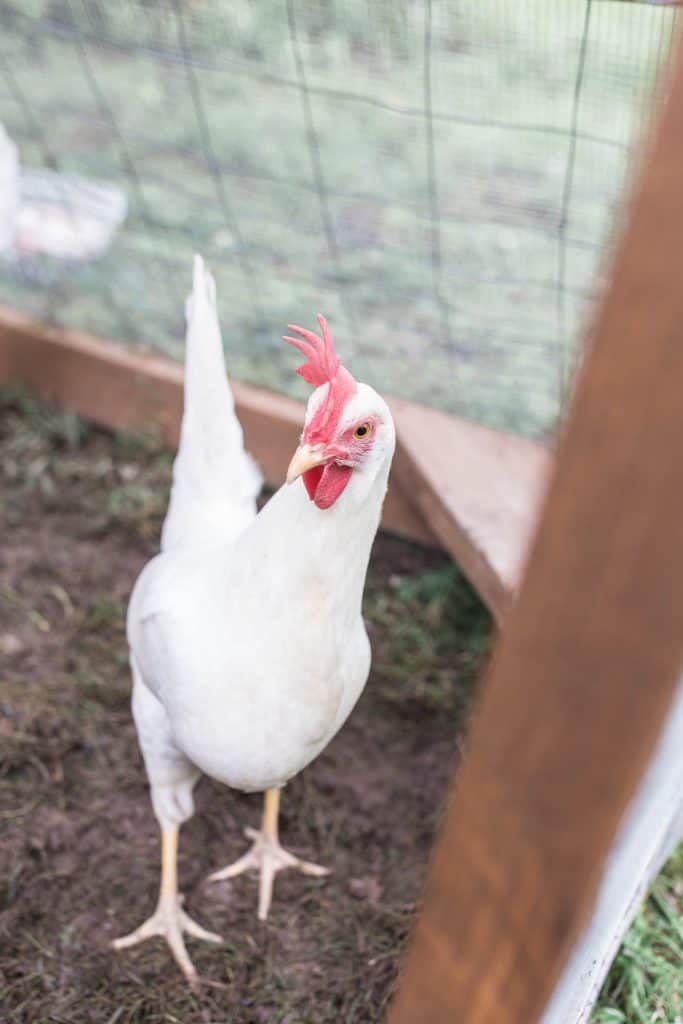
Breeds of Chickens
Now, as far as breeds, you are going to want to do some research to figure out what types are best for your needs and your geographical location.
Some chickens are able to tolerate hot environments, while others do better in cold environments. You should find the breeds of chickens that will do well in your area, and your local farm store should be able to give you this information.
For us, we bought the Rhode Island Red and Leghorn breeds. We have had them before, and loved that they are really high egg producers.
Certain chickens are better for meat, while others are better suited for egg laying. While there are still others known as dual purpose breeds.
These breeds can be used for both meat or egg laying, including: Rhode Island Red, Buff Orpington, Jersey Giant, Black Australorp and others. These breeds would be good for those who want eggs, but also want some soup at the end of the chicken’s laying period.
Egg Laying Chickens
A high-producing chicken is one that lays one egg a day. In the middle of summer, when it is warm and there are long daylight hours, you will get the same number of eggs as you have chickens.
It takes about six months for chickens to start laying eggs regularly, and they start to slow down in their production around age two.
Thus, about every other spring or fall, depending on what cycle you are on, you want to buy a new batch of chicks. When the ones you bought the previous year start to slow in their egg production, your new chicks will be ready to start laying eggs.
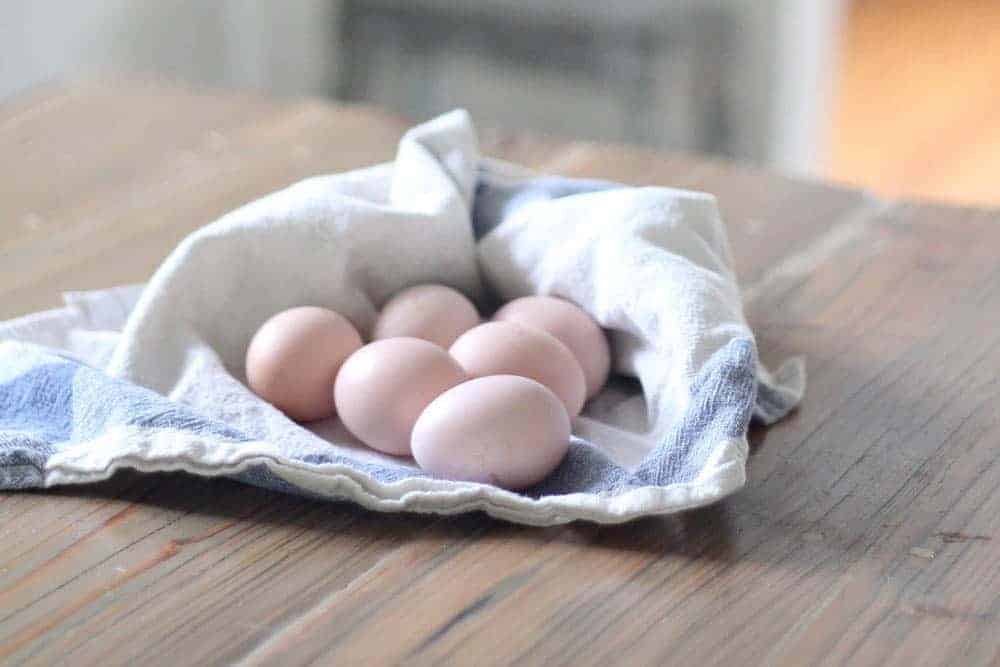
Best Egg Laying Chicken Breeds
- Australorp
- Rhode Island Reds
- Barred Plymoth Rock
- Wyandotte
- Sussex
- Marans
- Leghorn
- Buff Orpington
- Easter Eggers
- Ameraucana
Daily Chicken Chores
Chickens are probably one of the easiest farm animals to care for. They really need three essential things: food, water, shelter.
Let them out each morning, make sure they have clean water and plenty of food, collect eggs, and have a place to lock them up at night.
Depending on the type of coop and cleaning schedule, you may need to clean out the coop weekly, or more or less frequently.
Those who choose the deep bedding method may clean their coops less often than those who choose a more standard cleaning schedule. Make sure they have nice clean bedding for a healthy home.
How to take care of chickens in the winter:
I actually wrote an entire post on this that you can find here.
Easy Backyard Animals
And that’s it! Backyard chickens are seriously one of the easiest ways to get into home food production! They are a great way to start a homestead, even if you live on a quarter of an acre like we did.
I remember last summer, while we were still living in our old farmhouse, feeling so accomplished coming inside from the garden with my huge basket of produce, flowers, and five fresh eggs from the coop on our little plot of land.
And now, with more land and more chickens, I am so excited to start having eggs from our chickens with the nice and bright yellow yolks again.
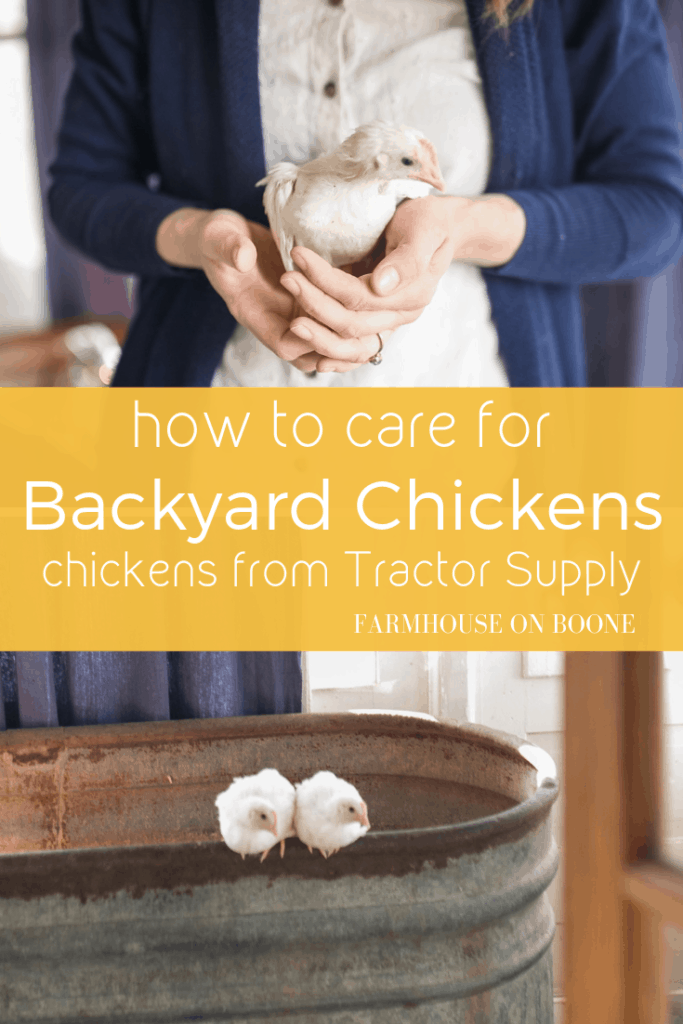







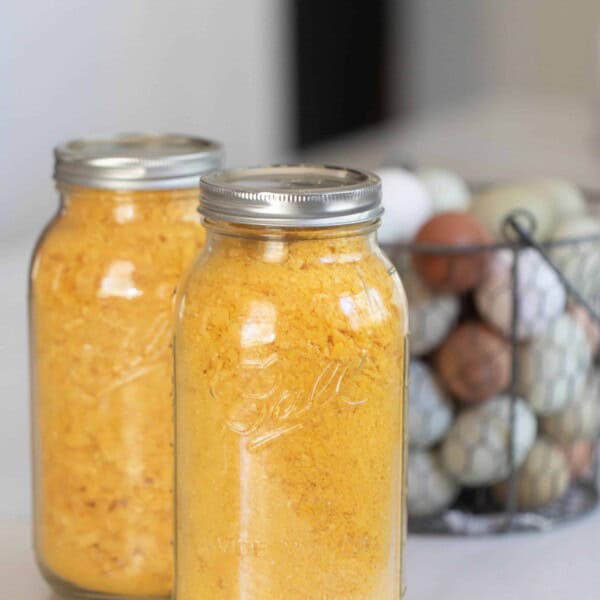
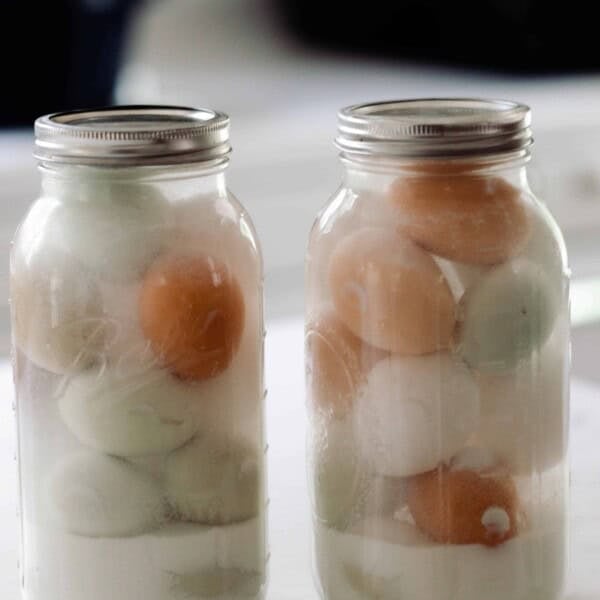
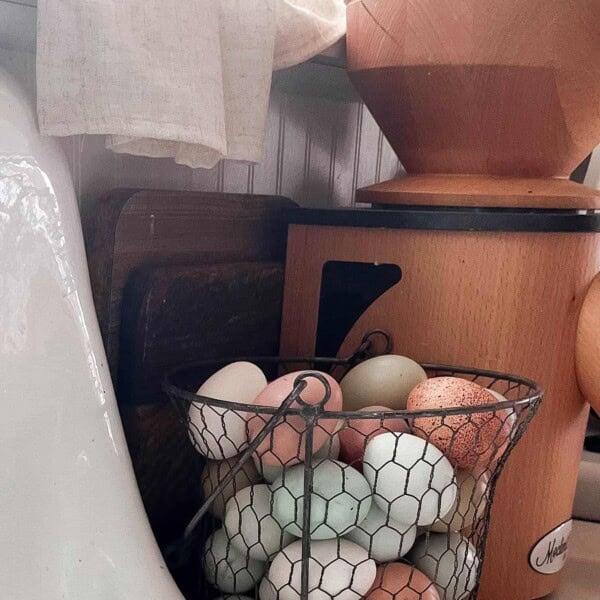






Thank you so much for all the wonderful info! I have wanted chickens for years and I am hoping this year will be the one I’m brave enough to do it!
I love chickens and still have one of my oldest hens who will turn 8 in May. They all are named and allowed to live their lives out whether or not They are laying eggs. I look forward to seeing your chicks grow and their new coop. We do have a TS in our Texas town so I would love to enter your giveaway. Thanks!
We don’t have chickens on our little suburban half acre, but I have been thinking about it for years. We have kids that pretty much line up with yours and also homeschool…. there’s never a dull moment. But I think the kids would be big enough to help now, so it may be a good time at last.
Oh my…we moved all around the world (we were a military family). But I always dreamed of the day my husband would retire (which he did) and we’d be able to put down roots and be able to raise a garden and some chickens. When that day finally came and we were able to settle down – my husband passed away suddenly and in the six years since I had given up on having either. But this year…my hunger for a garden has returned in earnest. And so has my desire to have chickens to raise and enjoy. Thank you for addressing this topic – you actually answered all my questions. Guess I will be building a chicken coop in the next week or two!!
We are raising up our 3rd flock of chickens. I have several wanna be farm children so this is an area where we can facilitate their little wishes, hopes, and dreams. (My husband is not a farmer but a pastor) We bought our 8 chicks from TSC and are working on building a moveable coop for them (aka tractor). It’s been a learning process designing each one (Also our 3rd chicken tractor). Looking forward to seeing how you all build your A frame one. I appreciate your heart on home making and found you thru YouTube. I feel like your views on many areas of life resonate with mine. Plus, you are a MO gal! I was originally but have been planted in MI.
I soooo wish to have chickens. My husband is in the military so we aren’t getting ready to be stationed in North Carolina from California! Hopefully, we will be getting chickens then ❤️❤️❤️
I don’t have chickens. I would love to start having them. This was a great video to explain how to start without it being complicated. Thanks so much!
We as a homeschooling and wild foraging family just moved out into the country to really get into homesteading. We started chickens last July and loving our 11 hens and our rooster named Crazy. Lol. I am a mother of 8 and me and my girls just love watching you and becoming inspired more and more with your channel. Keep up the great shows! ❤❤❤
No chickens yet on our 3 1/2 acre farm yet but I do have hope! I would love to make a mobile chicken coup like yours so maybe soon. Thanks for the Tractor Supply give away! My fingers are crossed!
We have 15 hens and one rooster. Love them!